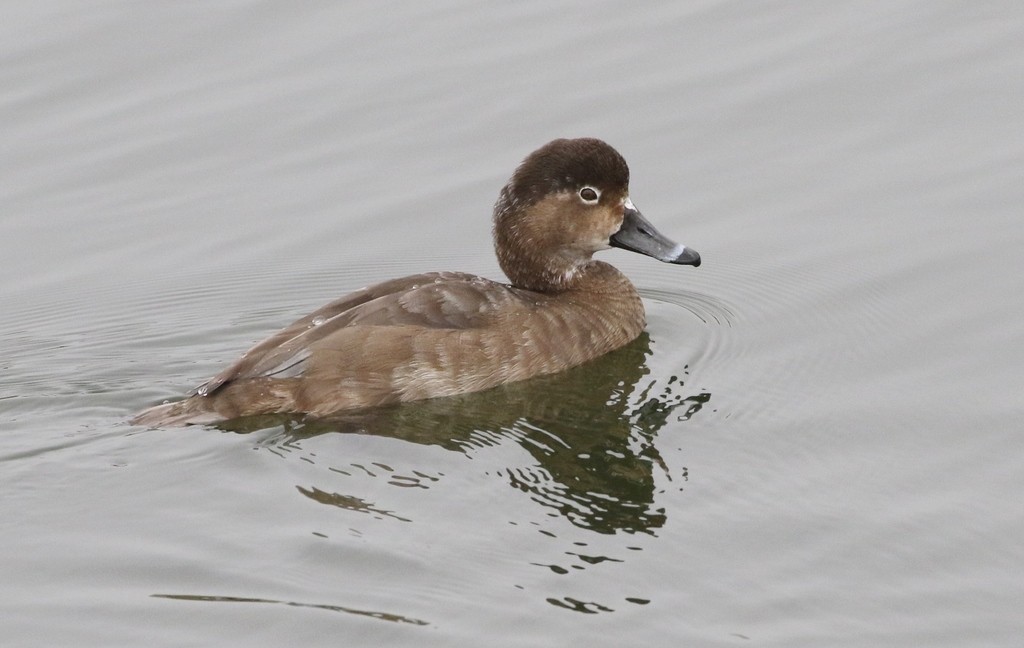Ring-necked Duck
A species of Diving ducks Scientific name : Aythya collaris Genus : Diving ducks
Ring-necked Duck, A species of Diving ducks
Botanical name: Aythya collaris
Genus: Diving ducks
 Photo By silversea_starsong , used under CC-BY-NC-4.0 /Cropped and compressed from original
Photo By silversea_starsong , used under CC-BY-NC-4.0 /Cropped and compressed from original Description
Ring-necked ducks are small to medium-sized diving ducks with the following length, weight, and wingspan measurements: Length: 15.3-18.1 in (39-46 cm) Weight: 17.3-32.1 oz (490-910 g) Wingspan: 24.4-24.8 in (62-63 cm) The adult male is similar in color pattern to the Eurasian tufted duck, its relative. Males are a little bit bigger than the female. It has two white rings surrounding its gray bill, a shiny black angular head, black back, white line on the wings, a white breast and yellow eyes. The adult female has a grayish brown angular head and body with a dark brown back, a dark bill with a more subtle light band than the male, grayish-blue feet and brown eyes with white rings surrounding them. Females also make a noise like trrr. The cinnamon neck ring is usually difficult to observe, which is why the bird is sometimes referred to as a "ringbill". 
Size
36-46 cm (14-18 in)
Colors
Black
Gray
White
Life Expectancy
20.4 years
Nest Placement
Ground
Clutch Size
6 - 14 eggs
Incubation Period
1 brood
Number of Broods
25 - 29 days
Nestling Period
1 - 2 days
Feeding Habits
Ring-necked Duck's diet comprises aquatic plants like pondweed and water lilies, and invertebrates like mollusks and insects. They feed by diving or dabbling, crucially consuming protein-rich animal matter during breeding season, especially females. Ducklings rely on insects and snails, shifting to more plant-based foods as they mature.
Habitat
Ring-necked Duck thrives in northern North America's freshwater environments, such as marshes, bogs, and shallow lake margins rich in dense aquatic vegetation. They prefer water depths of less than four feet and are commonly seen in beaver ponds and man-made water bodies. During migration and winter, they inhabit shallow waters with abundant emergent plants and brackish estuaries.
Nest Behavior
Construction commences once ring-necked Duck begins laying eggs, with a simple, initially flimsy structure of plant stems. Egg laying follows, and the female incubates and cares for the brood, with nests typically situated 1-10 inches above water.
Nest Characteristics
Ring-necked Duck typically selects dense sedges or emergent plants in marshes for nesting, preferring spots directly over water or on floating vegetation. The nest is an 11-inch wide and 2-4 inch deep bowl of sedges lined with the female's down, often with a ramp for access.
Dite type
Herbivorous
People often ask
Migration Overview
Their breeding habitat is wooded lakes or ponds in the northern United States and Canada. The main breeding area is Northwest boreal forest territories. Their breeding habits also take place in the eastern boreal region of Canada but no where near the same amount in the northwestern region. Winter months they are usually found in southern North America in lakes, ponds, rivers or bays. Ring-necked duck pairs start during spring migration. Unpaired ducks showing up on breeding grounds will most likely end up being non-breeders. The pairs stay together only for reproduction, until then, they separate. The nest is bowl-shaped, built on water in dense emergent vegetation with sedges and woody plants. The female lays one egg per day until 8 to 10 eggs are laid. They are incubated 25–29 days and the female may remain with the young until they are able to fly. 
General Info
Feeding Habits
Bird food type
Behavior
Ring-necked Duck display a varied repertoire of behaviors throughout their daily routine, primarily revolving around diving to forage underwater using their feet for propulsion—a contrast to the 'tipping up' feeding style of dabbling ducks. They are noted for their social behavior, often found in pairs during the breeding season and congregating in large flocks while migrating or wintering. During breeding, ring-necked Duck engage in complex displays for mate selection and territorial defense, including bill-lowering, breast-to-breast pushing, and in more intense encounters, biting and wing striking. Courting males exhibit dramatic gestures such as head throwing, rapid swimming with head nodding, and feigned preening. Pair bonding rituals are marked by synchronized neck stretching and bill dipping, with partnerships forming in spring, persisting at least until incubation.
Species Status
Not globally threatened.
Scientific Classification
Phylum
Chordates Class
Birds Order
Waterfowl Family
Geese Genus
Diving ducks Species
Ring-necked Duck